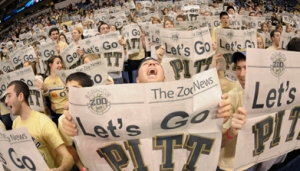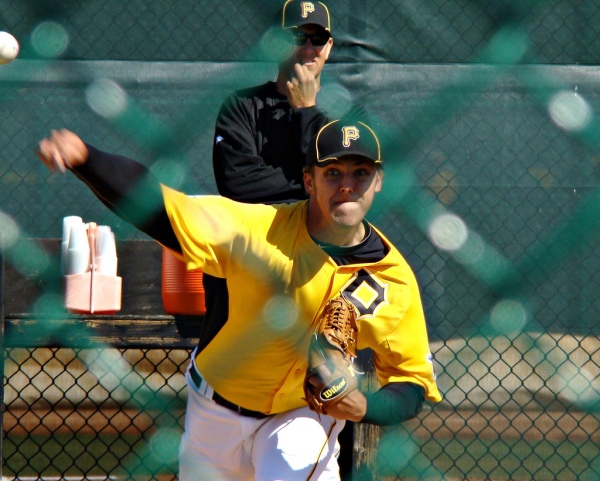IMPORTANT NOTE: This is a 2014 blog post laying out a “blue sky” idea for a Pitt football stadium. This piece does not represent driving/parking advice for Pitt campus events.
If you’re new to this series, please check out Part I (discussing my two-stadium solution for Pitt football) and Part II (my concept for the new stadium in the middle of Oakland).
Okay, you all caught up? Let’s move on to parking and traffic. How exciting!
Currently, Pitt sells 10,000 student season tickets to its home schedule at Heinz Field. Let’s bump that up to 13,000 at New Pitt Stadium, since part of our purpose is to improve the football experience for students. That leaves 28,000 seats for the general public.
Okay, some back-of-the-envelope math as to how we are going to get all these people to a Saturday game.
- 11,000 students walking from campus
- 2,000 students driving (hey, Pitt kids often go home for the weekend)
- 6,000 public fans walking/transit/biking/taxi
- 22,000 public fans driving
If you tack on 1,000 extra people driving and parking (staff and gameday workers), that means New Pitt Stadium will need parking spaces for about 25,000 people.
Only counting the 25 largest lots and garages, the University of Pittsburgh, Carnegie Mellon University and UPMC own more than 10,000 parking spaces within one mile of my proposed New Pitt Stadium.
Here is where the math gets easy:
Could it really be that easy? Yes and no. The parking exists to support New Pitt Stadium, the issue is how much event parking Pitt would be able to access. Let’s dive in deeper:
Pitt- and CMU-owned parking

The stadium site is in green and blue. The largest Pitt and CMU lots/garages are in red. UPMC lots/garages are in purple.
If you’re running a university, you need far fewer parking spaces on a Saturday than you need Monday through Friday. Obviously. Students and professors and staff and all that.
We also want to ensure football cars don’t take up spots on the street and in smaller lots. Businesses and other institutions still operate on Saturdays in Oakland, and they need their own spots for patrons, employees and residents.
Luckily for us, the University of Pittsburgh and Carnegie Mellon have built plenty of parking for their weekday needs. Counting only the 16 largest garages and lots between the two schools, there are 5,400 parking spaces available in Oakland within one mile of New Pitt Stadium.
For example, New Pitt Stadium would be directly next to the 934-space Soldiers & Sailors Garage, one of the largest parking garages in the city (attention: boosters and donors), and a 7-minute walk from CMU’s 328-space Dithridge Garage. You know the big CMU garage on Forbes Avenue, next to the football field? That one has 822 spaces, about a 15-minute walk or short shuttle ride to the stadium.
Already, I’m impressed. Pitt and CMU already own more than 5,400 spaces within walking distance of the stadium, compared to the mere 2,000 walking-distance spaces Tulane has available for its new stadium. In all, Pitt and CMU own or lease 7,800 spots in Oakland, according to the university’s recent master plans.
Under my plan, Pitt would need only to construct one new parking garage: a 500-spot garage to replace some of the spots lost to the stadium site. Perhaps the garage could be build on the Panther Hollow lot (already home to 108 spaces).
Now let’s scare up some more spots from UPMC.
Hospital Garages
UPMC’s 10 largest parking garages/lots in Oakland make up 5,000 spaces. The Presbyterian and Montefiore garages alone have more than 2,000 parking spots, and UPMC is planning to add 900 more spots to those garages by 2023.
Let’s make an assumption here: UPMC will soon have about 6,000 parking spaces in Oakland. Can Pitt reserve 2,600 of those spaces for event parking five Saturdays every year? Can they reserve 500 spaces of the new 1,500-space garage at the VA Hospital? Let’s say so and add those in.
Among Pitt-, CMU- and UPMC-owned parking facilities, we have reserved about 9,000 event parking spaces within walking distance of the stadium. But there are more out there.
Day-of-Sale Shuttle Garages
Because Tulane had so few on-campus parking spots available for their new stadium, their parking plan required 8,600 park-and-ride lots for fans, mostly in the university-owned pediatric hospital north of New Orleans and the Superdome.

Tulane also had to fit its new on-campus stadium (Capacity: 30,000) into a tight spot in a busy neighborhood.
Pitt won’t need so many park-and-ride spots. But the university should reserve such spots for out-of-town fans who did not reserve parking in advance. Parking these fans outside of Oakland and shuttling them in would reduce traffic in Oakland on game days.
For instance, directing Parkway East and West drivers could be directed to the Pittsburgh Technology Center garage (470 spaces) and Second Avenue lot (253 spaces) south of campus and take a 10-minute shuttle ride to the stadium.
And even though I hate to say it, the best park-and-ride lot for drivers from the north would be… Heinz Field. Maybe Pitt alums feeling nostalgic for the bus rides from campus to the North Shore can park there and hop aboard.
Again, not many park-and-ride lots are needed, given our plan of 8,500 event parking spaces near campus. But if a game sells out, it may behoove out-of-town fans to leave their car off campus instead of battling gameday traffic on the streets of Oakland.
What About the Traffic?
Four policies will do a lot of good to reduce traffic in Oakland on football game Saturdays.
1. Fans must purchase their spot in advance to park in a Pitt, CMU or UPMC garage.

Large print on parking passes allow staffers to direct drivers more easily to their garage.
From the Tulane stadium traffic study:
“The best solution for eliminating traffic in the surrounding neighborhoods is to adopt a policy of no cash parking in and around campus, period. Force all parkers to pre-purchase their parking ahead of time and anyone else should be pushed out to the park-and-ride lots.”
Such a policy would reduce the number of cars cruising for cash parking garages — there would be none. If Pitt mails free permits to donors and urges other season-ticket holders to purchase their spots before the season, thousands of fans will drive into Oakland with no doubt as to their parking destination.
2. Free transit passes for fans who purchase advance tickets.
Pitt and CMU already provide free transit passes for their students — both a perk for students and a policy that reduces traffic and parking shortages in Oakland.
The same plan can work with fans. When Pitt mails tickets to season-ticket holders and advanced purchasers, include a free transit pass good for the day of the game. If that fan lives near a bus line that can take him into Oakland, it’s a chance for him to travel to the game without having to pay for parking.
3. Include specific directions on the parking passes.

Give fans turn-by-turn directions to their garage. Tell them: ignore your GPS, this is the best way to go.
This again is from the Tulane plan. They included turn-by-turn directions from the fan’s address to their parking spot, optimized to reduce congestion on streets near the stadium.
“This will greatly reduce confusion, and the ‘circulating’ traffic, creating a more smooth ingress and egress,” the plan read.
If fans follow the directions instead of their GPS, they will spend less time on the road and clogging up busy intersections.
4. Plan events several hours before and after the game.
Pitt should try to reduce the amount of traffic in the hour before kickoff and the hour directly after the end of the game.
Let’s take this Saturday for example. Say Pitt were playing Georgia Tech on campus for homecoming instead of at Heinz Field. For a 3:30 kickoff, the goal should be to get as many fans on campus as possible by 1:30 p.m. and in the stadium by 3:00 p.m. (we want to be mindful of foot traffic in and out of the stadium too).
Pitt could offer family tailgates, fan fests and band performances on campus as early as 11:00 a.m. Then inside the stadium, early-arriving fans can get discounts on food and Pitt merchandise to encourage folks to be in the building by 3:00 p.m.

Give Pitt fans an all-day football experience and lower congestion.
After the game, partner bars and restaurants can offer food and drink deals to Pitt ticket holders (subsidized by the university) in order to keep fans from immediately rushing to the parking garage and causing traffic congestion in the streets.
Offering fans the opportunity to enjoy a full day on campus, as well as reducing congestion on game day? That’s a win-win, and it would help create the fun atmosphere and buzz that building an on-campus stadium is all about.
Of course, this is all a plan for the year 2014. Maybe the future will make a New Pitt Stadium easier to plan for. The mythic Spine Line rail expansion between Downtown and Oakland could become reality. Some brainy CMU student could come up with a new driverless transportation system that would make event parking unnecessary. Who knows what the future will bring?
We’ll wrap this all up tomorrow as Part IV examines how other schools have paid for new stadiums over the last decade. Until then, I leave you with a quote from the company that performed the traffic study for Tulane, a school that also had citizens concerned about neighborhood congestion and lack of parking for an on-campus football stadium.
“In short, we do see some associated risks with the plans and operation of the stadium and campus at this time,” the study for Tulane read. “But none of them are insurmountable by any means.”
Not insurmountable? That’s good enough for me.
























